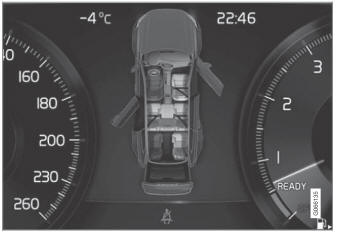Volvo XC90 2015-2025 Owners Manual / Starting and driving / Emission controls
Volvo XC90: Starting and driving / Emission controls
Three-way catalytic converter
- Keep your engine properly tuned. Certain engine malfunctions, particularly involving the electrical, fuel or distributor ignition systems, may cause unusually high threeway catalytic converter temperatures. Do not continue to operate your vehicle if you detect engine misfire, noticeable loss of power or other unusual operating conditions, such as engine overheating or backfiring. A properly tuned engine will help avoid malfunctions that could damage the three-way catalytic converter.
- Do not park your vehicle over combustible materials, such as grass or leaves, which can come into contact with the hot exhaust system and cause such materials to ignite under certain wind and weather conditions.
- Excessive starter cranking (in excess of one minute), or an intermittently firing or flooded engine can cause three-way catalytic converter or exhaust system overheating.
- Remember that tampering or unauthorized modifications to the engine, the Engine Control Module, or the vehicle may be illegal and can cause three-way catalytic converter or exhaust system overheating. This includes: altering fuel injection settings or components, altering emission system components or location or removing components, and/or repeated use of leaded fuel.
NOTE
Unleaded fuel is required for vehicles with three-way catalytic converters.
Heated oxygen sensors
The heated oxygen sensors monitor the oxygen content of the exhaust gases. Readings are fed into a control module that continuously monitors engine functions and controls fuel injection. The ratio of fuel to air into the engine is continuously adjusted for efficient combustion to help reduce harmful emissions.
 Octane rating
Octane rating
Volvo requires premium fuel (91 octane1 or higher) for all T5, T6
and T8 engines, and recommends AKI 93 for optimal performance and fuel economy.
See decal examples in illustrations 1 and 2...
 Overheating of engine and transmission
Overheating of engine and transmission
In certain driving conditions, such as driving in mountainous areas or hot
weather, there is a risk of the engine or transmission overheating, especially when
carrying heavy loads...
Other information:
Volvo XC90 2015-2025 Owners Manual: Reset procedure for pinch protection
If you experience any problems with the electrical functions for the power windows, you can try to perform a reset. WARNING If the starter battery is disconnected, the function for automatic opening and closing must be reset to function correctly. A reset is required in order for the pinch protection to work...
Volvo XC90 2015-2025 Owners Manual: Care Key – restricted remote key
A Care Key enables the vehicle owner to set a maximum speed limit for the vehicle. This limit is intended to promote safe use of the vehicle, e.g. when it is loaned out. A maximum vehicle speed can be defined for a Care Key. Otherwise, the Red Key functions in the same way as a standard remote key...
Copyright © 2025 www.voxc90.com

